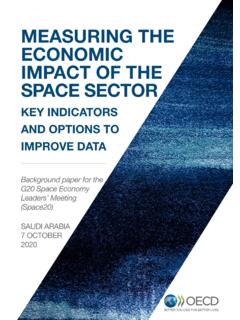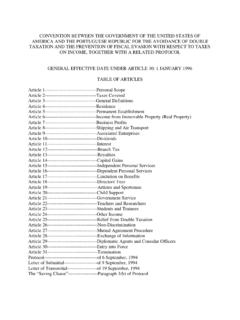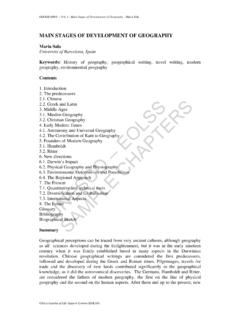Transcription of The Public SPhere - GOV.UK
1 The Public SPhere The notion of the Public SPhere is at the center of participatory approaches to democracy. The Public SPhere is the arena where citizens come together, exchange opinions regarding Public affairs, discuss, deliberate, and eventually form Public opinion. This arena can be a specific place where citizens gather (for example, a town hall meeting), but it can also be a communication infrastructure through which citizens send and receive information and opinions. The Public SPhere is a central aspect of good governance. Without a func- tioning and democratic Public SPhere , government officials cannot be held accountable for their actions, and citizens will not be able to assert any influence over political decisions.
2 The idea of the Public SPhere is normative. It is an ideal of good and accountable governance. Its requisites are free flows of information, free expression, and free debate. The ideal Public SPhere is truly participa- tory and the best protection against abuse of power. In reality, we only find approximations to this ideal. However, promoting good governance means striving toward the ideal of a truly inclusive Public SPhere . Historical Roots of the Public SPhere To understand the meaning and the nature of the Public SPhere today, it is helpful to look at the historical development of the meaning of the term. Its meaning has always been closely tied to historical circum- stances and to technical developments.
3 The historical trajectory also highlights the relevance of the Public SPhere for promoting democracy and political accountability. Originally, the Public SPhere was a specific meeting place. With the development of media and communica- tion technology, the character of the Public SPhere changed from a location to a communication Ancient Greece The most general understanding of the Public SPhere comes from the Ancient Greek city-states, where citizens directly participated in political Public life was tied to a specific locale, the agora, where citizens exchanged and discussed opinions. european Monarchies In the non-democratic state-forms of later centuries, the Royal court was the Public SPhere , and only the king determined what was Public .
4 Salons Over the course of the late 17th and early 18th centuries, coffeehouses (England), salons (France), and table societies (Germany) became places where aristocrats and members of the middle class met to discuss art and politics. In these gatherings, authority of argument supplanted the authority of title, 3 social status became disregarded With the development of the first mass medium, the newspaper, the groups that met in salons and coffee houses became truly Public : news- papers made Public affairs and discussions about such affairs accessible to individuals scattered across space. 5 Technically, this denotes the advent of what is today understood as Public SPhere .
5 1 Splichal, S. (1999). Public opinion. Developments and controversies in the twentieth century. Lanham, MD: Rowman & Littlefield. 2 Habermas, J. (1962/1995). The structural transformation of the Public SPhere : An inquiry into a category of bourgeois society. Cambridge: MIT Press. 3 Price, V. (1992). Public opinion. Newbury Park, CA: Sage. (p. 9). 4 Habermas (1962/1995). 5 Splichal (1999, p. 23). The Public SPhere | CommGAP. Tribal gatherings In stateless communities in Africa or in regions with strong tribal traditions, tribe gatherings have similar functions as Western citizen assemblies, or indeed the ancient agoras. Such meetings represent the Public life of the tribal community.
6 Church congregations In periods of political struggle, the Church often provided a space for members of oppressed or marginalized groups to gather and articulate their objectives. Today Today, the Public SPhere is even more strongly tied to the media. It is defined in relation to the mass media, because the mass media permit the circulation of opinion and offer the conditions in which the forum can function. 6 The term gained new prominence with the spread of new commu- nication technologies in the 1990s. The Internet in particular is considered to provide unprecedented opportunities for exchanging information and for deliberation among a large number of people of different backgrounds.
7 Access for minority voices and political outsiders is considered to be essential to a well-functioning Public Defining the Public SPhere The concept of the Public SPhere has a long tradition in philosophy and the social sciences. The contempo- rary understanding of the term is mainly based on the work of German sociologist J rgen Habermas, who provided a comprehensive analysis of the nature of the Public SPhere and its historic He defines the Public SPhere as network for communicating information and points of view .. the streams of communication are, in the process, filtered and synthesized in such a way that they coalesce into bundles of topically specified Public opinions.
8 9. The Public SPhere is situated between private households on the one hand, and the state on the other. It is a space where free and equal citizens come together to share information, to debate, to discuss, or to deliberate on common concerns. 10. Until the invention of the printing press, citizens came together in a particular space, for instance a coffee- house, where they discussed with other people. The development of mass communication has changed the nature of the Public SPhere from a physical space to a communication Today, people can get in touch through telephone or the Internet, and they can find out about what other people think by reading a newspaper editorial or by watching local television news.
9 Therefore, today's Public SPhere goes beyond space and includes all channels of communications through which citizens can send and receive informa- tion. This two-way-flow of communication is essential: A Public SPhere does not exist if, for instance, a government publishes information but does not listen to the people. The Public SPhere is for the state what the market is for the In the Public SPhere , the goods that are exchanged and the currency that is traded are not of economic, but of political nature. The main 6 Bentivegna, S. (2002). Politics and new media. In L. Lievrouw & S. Livingstone (Eds.), Handbook of new media: Social shapings and consequences of ICTs (pp.)
10 50 60). London: Sage. (p. 52). 7 Marx Ferree, M., Gamson, W. A., Gerhards, J., & Rucht, D. (2002). Four models of the Public SPhere in modern democracies. Theory and society, 31(3), 289 324. (p. 299). 8 Habermas, J. (1962/1995). 9 Habermas, J. (1992/1997). Between facts and norms: contributions to a discourse theory of law and democracy. Cambridge: Polity. (p. 360). 10 Odugbemi, A. (2008). Public opinion, the Public SPhere , and quality of governance: An exploration . In S. Odugbemi & T. Jacobson (Eds.), Governance reform under real-world conditions. Citizens, stakeholders, and voice (pp. 15 37). Washington, : The World Bank. (p. 17). 11 Habermas, J.

















